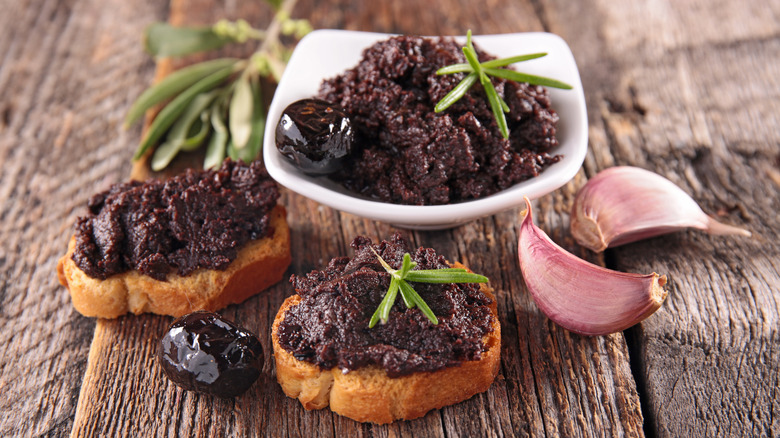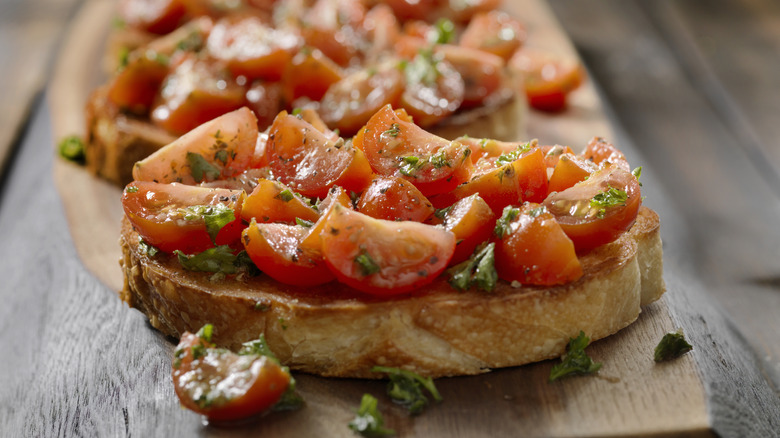What Really Sets Tapenade Apart From Bruschetta
Bruschetta and tapenade are both delicious appetizers that embody simple European cooking, and even if you've made them before, you might be surprised by the definition of each dish and what makes them so different. To start with, tapenade is French spread commonly made with olives as the primary ingredient. Capers are the second most important element — the word tapenade comes from the Provençal word "tapenos," meaning capers.
These ingredients are pounded together with oil and other ingredients like anchovies, garlic, and herbs. The result is a rich, intensely-flavored spread that is great on bread, as a dip, or as a sauce. Meanwhile, bruschetta has a much broader definition, but it must use a base of toasted bread. It has origins as an ancient Roman peasant food, as poor villagers would grill stale leftover bread to make it palatable. The name bruschetta refers to the Italian word "bruscare," meaning "to roast over coals" in English.
Over the years, bruschetta has come to refer to any kind of Italian toast with toppings. A tomato topping is most well-known, but the dish can be made without tomatoes, in a range of complex to extremely simple styles. In fact, a piece of toast with olive oil and garlic qualifies as bruschetta (so next time you make a simple garlic bread, you can fancy it up by calling it garlic bruschetta). That said, tomatoes are easily the most common topping, usually mixed with simple ingredients like basil, olive oil, and salt.
Tapenade and bruschetta are served differently, too
Beyond their different ingredients and flavors, tapenade and bruschetta are used in different ways, though there is some overlap. Like bruschetta, tapenade is often served on bread. This olive-based condiment, however, is more smooth and spreadable, whereas traditional tomato bruschetta is chunky and must be spooned onto toast. Tapenade is also much saltier due to the brined olives, capers, and optional anchovies.
While tapenade can be served as a snack or appetizer, it's also often used as a component in larger dishes. In the south of France, tapenade is often rubbed under the skin of a whole chicken before roasting it. Similarly, it can be found accompanying grilled or roasted fish, since the salty and sharp flavors pair well with seafood. The spread has a lot of global influence, too; Louisiana's Muffaletta sandwich uses a relative of tapenade, olive salad, as one of its key components.
On the other hand, while there are as many kinds of bruschetta as there are ingredients to put on toasted bread, you would not add bruschetta to something else to create a new dish — it comes as a complete package of toppings and bread. Some bruschetta toppings can taste quite similar to tapenade, like olives and/or anchovies (in fact, it's totally valid to just spread tapenade on your bruschetta!). More unique regional toppings can range from pork salami (as found in Abruzzo) to chicken liver and kale (as found in Tuscany).
Tips for the best bruschetta and tapenade
A must-do for delicious bruschetta or tapenade is to start with great ingredients. For tapenade, that means sourcing high-quality olives. Black, oil-cured olives from Nicoise are a classic option, as are Italian Cailletier varieties. Greek Kalamata olives are also readily available at most supermarkets and will work in a pinch. Fresh parsley, basil, or herbs de Provence will add an herbal flavor that cuts through the salty ingredients in the spread.
You can blitz your tapenade together in a blender for convenience's sake, but you will get even better results from a mortar and pestle. Pounding the ingredients this way creates a more luxurious texture, while also drawing extra flavor and aroma out of the ingredients by pulverizing their cell structure.
When making a classic fresh tomato bruschetta with basil, you want to start with the ripest fruit you can find. You should try draining the tomatoes by chopping them, salting them, and then placing them in a colander; this concentrates their flavor and reduces the amount of liquid that will hit the bread, keeping it crisp. Rubbing a baguette with garlic before toasting is a traditional technique, but you can also add fresh garlic directly to the tomato-basil mixture. Use a rustic, crusty French or Italian bread and cover each piece liberally with olive oil before grilling them (or toasting, in a pinch). The olive oil will infuse the bread with flavor and help it brown for the perfect base.



